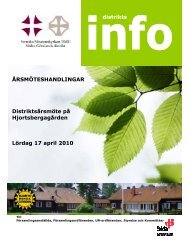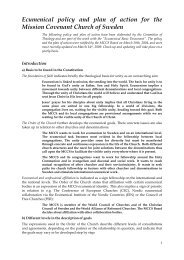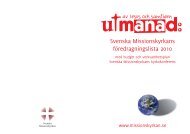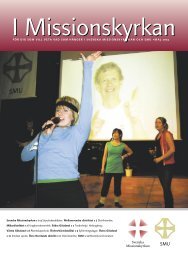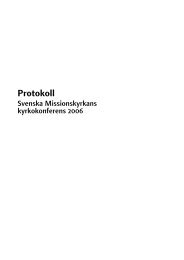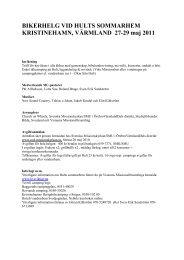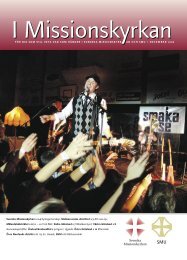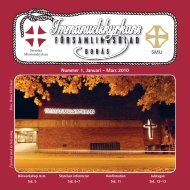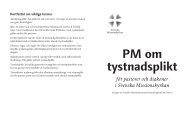Mission and Revolution in Central Asia - Svenska Missionskyrkan
Mission and Revolution in Central Asia - Svenska Missionskyrkan
Mission and Revolution in Central Asia - Svenska Missionskyrkan
Create successful ePaper yourself
Turn your PDF publications into a flip-book with our unique Google optimized e-Paper software.
give a lengthy speech to warn the schoolboys. Once he described <strong>in</strong> detail how dangerous<br />
these festivals could be. He told them about boys turn<strong>in</strong>g completely corrupt dur<strong>in</strong>g those<br />
weeks. And, he added, it was much more tempt<strong>in</strong>g to act “off limits” while the festival was<br />
on, s<strong>in</strong>ce nobody was punished dur<strong>in</strong>g these celebrations. “Don’t take part <strong>in</strong> the div<strong>in</strong>ity<br />
processions. That ghastly dummy, the Fire God with those extra eyes pa<strong>in</strong>ted bright red is<br />
noth<strong>in</strong>g but an image made of strips of wood, rags <strong>and</strong> plaster pa<strong>in</strong>ted red <strong>and</strong> given eyes<br />
made of pieces of look<strong>in</strong>g-glass. How do you expect someth<strong>in</strong>g like that to actually protect<br />
the town from fire? Don’t take part <strong>in</strong> carry<strong>in</strong>g that scare-crow through, the town!” He went<br />
on to say that he thought it a shame, that nearly twenty years after the Republic had been<br />
<strong>in</strong>troduced, there were still “fools believ<strong>in</strong>g <strong>in</strong> this”. 134<br />
The missionaries compla<strong>in</strong> of un<strong>in</strong>hibited “hell of gambl<strong>in</strong>g” dur<strong>in</strong>g the festivals. Even the<br />
normally haughty Muslims accepted to sit down at the gambl<strong>in</strong>g table of the despised<br />
Ch<strong>in</strong>ese. 135 The missionaries po<strong>in</strong>t out that dur<strong>in</strong>g the Festival weeks, people were totally<br />
unable to do any useful work. 136<br />
But if the Ch<strong>in</strong>ese national festivals were experienced by the Swedes as superficial <strong>and</strong><br />
repellent represent<strong>in</strong>g one extreme of the religion, they were also to learn about the other<br />
extreme, where people took their religious beliefs extremely seriously. One day a Ch<strong>in</strong>ese<br />
man came to Raquette with a problem. The man knew that Raquette had medical skills <strong>and</strong><br />
now he asked him to cut one open<strong>in</strong>g under each of his two collarbones. In these open<strong>in</strong>gs<br />
this pious Ch<strong>in</strong>ese wanted to put <strong>in</strong> wooden pegs, <strong>and</strong> then, his idea was to walk, <strong>in</strong> this<br />
condition, all the way to Beij<strong>in</strong>g, a walk of six months. As a result he hoped to become<br />
righteous <strong>and</strong> to f<strong>in</strong>d peace. 137<br />
Ancestor worship occupies an important place <strong>in</strong> the Ch<strong>in</strong>ese religious cult. It is the<br />
dom<strong>in</strong>at<strong>in</strong>g form of religion <strong>in</strong> the homes where the ancestor altar is to be found. The depth of<br />
the attachment of the Ch<strong>in</strong>ese to their deceased relations is shown by the fact that they never<br />
feel quite at home <strong>in</strong> any other prov<strong>in</strong>ce than the one where their ancestors are buried. As has<br />
been suggested above they wanted to return there when they themselves were approach<strong>in</strong>g<br />
death. 138 Ancestor worship is probably the one aspect of the cult that has best survived all the<br />
many radical changes of Ch<strong>in</strong>a <strong>in</strong> modern times. 139 The reason why the <strong>Mission</strong> had so little<br />
success among the Ch<strong>in</strong>ese was probably partly due to their feel<strong>in</strong>g of alienation <strong>and</strong> rootlessness<br />
<strong>in</strong> Eastern Turkestan, be<strong>in</strong>g so far away from home.<br />
After the <strong>Revolution</strong> of 1911 it became more <strong>and</strong> more common, accord<strong>in</strong>g to the<br />
missionaries, that the Ch<strong>in</strong>ese from Ch<strong>in</strong>a proper were atheists. If these immigrants still<br />
worshipped their old gods, they did it secretly <strong>in</strong> their homes.<br />
The Ch<strong>in</strong>ese religions were characterized by syncretism. This blend of religions had been<br />
go<strong>in</strong>g on for thous<strong>and</strong>s of years. The Ch<strong>in</strong>ese themselves did not m<strong>in</strong>d what temple they<br />
worshipped <strong>in</strong> or which div<strong>in</strong>ities were honoured. In Confucian temples both Taoist <strong>and</strong><br />
Buddhist div<strong>in</strong>ities were worshipped. In Hancheng for <strong>in</strong>stance the Buddhists had several<br />
temples but the Taoists none. They were however allowed to rent temples from the<br />
Buddhists. 140 Törnquist has the follow<strong>in</strong>g to say about the Ch<strong>in</strong>ese religions:<br />
134 Hem Hem, 1929, p. 18 ff.<br />
135 Lundahl, 1917, p. 141 f.<br />
136 Törnquist to the Board, July 6th, 1915.<br />
137 The <strong>Mission</strong>sförbundet 1898, number 1, p. 22 f.<br />
138 Lundahl, 1917, p. 100.<br />
139 R<strong>in</strong>ggren-Ström, 1968, p. 408.<br />
140 Lundahl, 1917, p. 140.<br />
17



